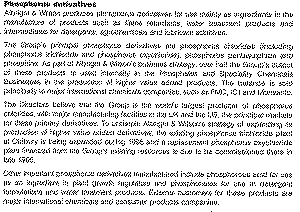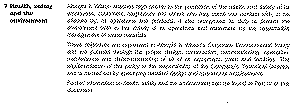Company number 1134915 may well be an obscure non entity known to the general public. It is however all that really remains- (except the dire pollution legacy), of the once second largest chemical company in the UK.
The dates of the demise of Albright and Wilson shown from the Tenneco ownership days are shown below, with the company now known as “Rhodia reorganisation Ltd”.
There are pages and pages of good stuff on the companies House website- particularly about the individuals who were running this environmental shambles from Trinity Street- or at some points a “world headquarters” in another part of Oldbury.
Extracts below are taken from a document concerning flotation of the company .
The historic context of this came when American owners Tenneco wanted disposal of the British company for restructuring of their key operations after a 24 year period of involvement with the firm. The announcement for AW shares came in late 1994.
This included 1,540,000 shares allocated to employees- I wonder how many “comrades” in Oldbury took up the offer? 😆 In just five years however , the company would no longer exist!
The brief makes reference to Albright and Wilson’s involvement with other environmental chemical polluters like Monsanto, as well as the planning application BCS 2336 for extending the phosphorus trichloride plant at Oldbury and also the phosphorus oxychloride plant.
Not content with trying to blow up the local area, (as well as poisoning the ducks and giving their employees phossy jaw), the company were forever trying to blow their own trumpet in terms of how they were saving the environment. They jockingly regarded it as one of their “strengths”.
The real truth was somewhat evidentially different.
“Albright and Wilson attaches high priority to the protection of the health and safety of its employees, customers, neighbours and others who they may come into contact with or be affected by, its operations and products. It also recognises its duty to protect the environment both in the vicinity of its operations and elsewhere by the responsible management of waste materials.”
You really could not make this bullshit up- and not mentioned in this little piece were the facts that within a five year period when this was written , a large phosphorus fire at their Portishead site had occurred as well as incidents at Oldbury- and of course the small matter of the 1991 Charlston explosion which killed 9 people- they didn’t get any shares.
The mention of waste materials is particularly important to this blog as the management of them was anything but “responsible” as evidenced by the site records at Rattlechain following on from the time.
The mention of the fact that the technical director was ultimately responsible for AW’s actions is interesting as we can all blame it on the gentleman from that time- namely John Robert Adsetts.
Albright and Wilson, like most polluters continue to operate, legitimised their activities through the device of the environmental consultant. In this case an American outfit called “Dames and Moore”- sounds like a swingers bar. This merged into URS in 1999- with which we are familiar from Rhodia’s subsequent paid reports. They were apparently appointed to survey all of Albright and Wilson’s operative sites, as well as those they still had to remediate.
Skip the bull below to the crucial statement in red underlined- because that is key- and the key from which all environmental consultants operate in reporting what their clients want them to. They undertook no analysis of site samples whatsoever in coming to conclusions.
“The Dames and Moore assessment did not take the form of a full range of investigations (in that no soil or groundwater sampling took place.. “
The letter from February 1995 from this company is also interesting.
“No significant issues were identified by us that were previously unknown to Albright and Wilson’s management…”
So does this mean that Dames and Moore investigated the operation at Rattlechain, the historic military disposal of phosphorus based weapons at the site and the risk of white phosphorus being ingested by birds as a known banned rat poison? So what did John Adsetts already know then at this time or was white phosphorus at this site just not deemed “significant”?
If I had known then what I know now- it would have been pretty bloody significant for him and his wretched company that’s for sure!
It would be interesting to see what Dames and Moore came up with at this site- but that report is likely buried well in the vaults of PO BOX 80. I attempted to ask the Environment agency about reports concerning restoration options that URS had apparently carried out in an FOI request-namely
CL Associates, “restoration Options for Rattlechain Sludge Lagoon, Oldbury, West Midlands, dated July 1996, reference no 6871 and
URS Corporation ltd, Options Study for restoration of the Rattlechain sludge lagoon, Ref 1064/44557-020-787/JC/RC, dated 20 March 2002
and they claimed to have never seen it.
The final company report for Albright and Wilson in 1998 also contains an interesting statement regards a Friends of The Earth report of that year where AW was heavily criticised for continued pollution.
Sales in the UK in that year hit £241.3, the same year that Adsetts retired.
So as these executives retired into a phosphorus sunset on golden pensions, so behind then was left the toxic legacy of their operations. According to Hugh Podger in his book “Albright and Wilson The last 50 years, “in September of 1999 Chief executive Paul Rocheleau stated that for the first time in 13 years with A&W it was possible to say that there were no significant environmental issues outstanding.”
Of course, we know different!













